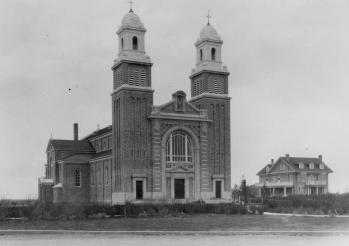
When the first Catholic missionaries and settlers came to Saskatchewan, one of the first community buildings to be constructed was the church. The first churches were necessarily humble affairs, but as time went on and the communities grew and prospered, more substantial structures were erected. When communities were able to do so, the churches were adorned with special works of liturgical art in the form of stained glass, statues and crucifixes, carved altars, stations of the cross, and specially constructed baptismal fonts, tabernacles and other liturgical items. The key church building in each diocese is its cathedral, which will often surpass ordinary churches in architectural design and décor.
Holy Rosary Cathedral, the mother church of the Regina archdiocese, was built in 1912-13 under the aegis of Olivier Elzéar Mathieu, Regina's first archbishop. It is of cruciform/Romanesque design, with elegant twin spires that dominate the skyline of Regina's west-central area, now known as the Cathedral District. The cathedral contains a series of stained glass windows designed by French artist André Rault, a ceramic mural by artist Lorraine Malach, entitled “The Glorious Mysteries,” and a Casavant organ which was rededicated in 1993 and named the McGuigan Casavant Organ in honour of Sister Marion McGuigan, educator and humanitarian. Holy Rosary Cathedral suffered a disastrous fire on April 12, 1976, in the south end of the church; the damage was repaired, the church redecorated, and a further redecoration took place in 1992.
Sacred Heart Cathedral was built on the site of the first Catholic mission in Prince Albert, near the banks of the North Saskatchewan River. It was completed in 1914 at a cost of approximately $103,000. The cathedral's exterior was constructed of a dark red-brown contrasting with naturally light Manitoba Tyndall stone. The cathedral was built in the form of a cross, in keeping with the Romanesque style, and buttresses help to support the walls. In niches above the doors are statues of the Virgin and Saint Joseph, and another niche in the apex of the roof holds a bronze statue of the Sacred Heart. The interior of the cathedral contains paintings by Count Berthold Imhoff and Peter Haip, high-relief Stations of the Cross, statues of Mary, Joseph, Saint Patrick, Saint John, and a life-size statue of the Sacred Heart, and beautiful stained-glass windows, four of which are twenty-five feet tall. Dedication of the cathedral took place on May 2, 1915.
St. Paul's Cathedral. The cornerstone of the present St. Paul's was laid by Sir Wilfrid Laurier on July 25, 1910, and a year later the completed church was formally dedicated by Archbishop Langevin of St. Boniface. A chime of Packard bells and a Casavan organ were installed in 1912. Although St. Paul's was named a pro-cathedral in 1921, it was not until March 1934, with the establishment of the new Diocese of Saskatoon, that it was elevated to the rank of cathedral. In 1945 stained glass windows were installed in memory of those parishioners who had lost their lives in World War II, and additional ones were installed following the fire of 1976. Because it was built as a parish church rather than as a cathedral, St. Paul's is simpler in style than the other Catholic cathedrals in Saskatchewan.
St. Peter's Cathedral. Benedictine monks arrived at Muenster, Saskatchewan on May 21, 1903. On June 29, the decision was reached by the monks and the first German-Catholic settlers to erect a 20' x 40' log church near the monastery. It was called St. Peter's Church in honour of Abbot Peter Engel, OSB, of St. John's Abbey, Minneapolis. In 1907 the foundations for the second, larger church (120' x 56') were laid. Financial difficulties delayed its construction until 1909, and the church with its two 60' towers was officially opened on July 10, 1910. When Count Berthold Imhoff visited the abbey in 1919, he offered to paint the entire sanctuary as a gift to Abbot Bruno Doerfler, his friend; this included eighty life-sized paintings of saints. Imhoff later painted the rest of the church for $3,000. He further honoured Abbot Bruno by painting the abbot's face on his depiction of St. Paul. On May 6, 1921, St. Peter's Colony became St. Peter's Abbey Nullius under the ecclesiastical jurisdiction of the abbot, with St. Peter's as the cathedral church. In 1998 the territory became part of the Saskatoon Diocese, and St. Peter's is no longer a cathedral.
Our Lady of the Assumption Cathedral. The patron of the church, when it was built in 1919 and later named cathedral church of the newly formed diocese of Gravelbourg in 1930, was St. Philomena. In 1963, the name of the cathedral was changed to Our Lady of the Assumption. The church building is considered to be a landmark in the Gravelbourg community. Of particular interest is the artwork of Fr. Charles Maillard, who between 1921 and 1931 embellished the church with scenes from the Old and New Testaments. The Bishop's Chair is a Louis XIV-style episcopal throne dated to 1780. Gravelbourg ceased to be a separate diocese in 1998, and its cathedral is now a “co-cathedral.”
Margaret Sanche